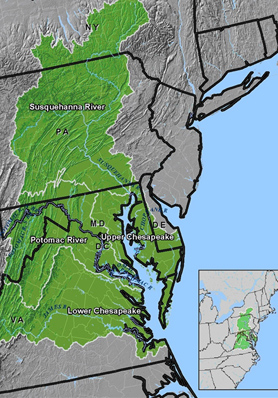USGA Supports Links To The (Chesapeake) Bay Environmental Initiative
April 21, 2010
By David Shefter, USGA
It’s no secret that our society has become much more environmentally conscious.
“Going green” is no longer just a crazy slogan, but an integral part of everyday life.
Whether it’s operating hybrid automobiles, recycling products such as aluminum, bottled beverages and newspapers or finding alternative-energy sources, people are playing a part in trying to ensure a better life for future generations.
That’s why Ron Dodson, the president of Audubon International, conceived Links to the Bay, an initiative designed for the 17 million inhabitants of the Chesapeake Bay watershed to protect one of America’s largest natural resources. Stretching from the south-central New York state through Pennsylvania, parts of Delaware, northern Virginia, eastern portions of West Virginia, the District of Columbia and finally to Maryland, the watershed is one of the country’s largest.
 |
Within those boundaries are 760 golf courses, 50 of which are certified by the Audubon Cooperative Sanctuary Program. Through partnerships with the United States Golf Association, the Mid-Atlantic Golf Course Superintendents Association and other nonprofit organizations, Dodson is hoping golf courses can lead the way in environmental stewardship to clean up a watershed that’s become progressively more polluted over the last quarter-century.
“What I am trying to do is position golf courses as leaders of the pack,” said Dodson, who has been Audubon International’s president since its founding in 1987. “We want to hold these golf courses up as exemplar demonstration sites as how you manage properties to improve the quality of water and provide wildlife habitat.”
Just how polluted has the Chesapeake Bay become? Dodson says the oyster population is down about 90 percent. During the summer months, a huge dead zone exists in the bay that is mostly devoid of oxygen. The cause is nitrogen pollution that has seeped down from rivers such as the Susquehanna and James, which hurts not only commercial fisheries but also tourism.
“It’s essentially killing the bay,” said Dodson.
While golf courses are not a major culprit, Dodson and Jim Snow, the national director of the USGA Green Section, understand the role the game can play in environmental preservation. Many courses have cut down the use of fertilizers and pesticides that can spill into ponds, creeks and rivers if not applied properly. And many superintendents are educating members and customers about the harm these chemicals can do to wildlife, estuaries and other forms of habitat.
Dodson also realizes that superintendents, especially those at private clubs, are under enormous pressure to keep their courses in pristine condition.
“It will be a slow process,” said Dodson, “not because there is a lack of interest, but because [superintendents] are very busy people and they are under a lot of pressure. Educationally, it’s a long-term process to convince people that a sustainable golf course starts with economic sustainability. If it’s not economically sustainable, then you can’t have all the environmental and social things that go along with it. We’re trying to make things easier, but we also are trying to help golf be better and look better.”
On May 18, the Akridge Save the Bay Classic will take place at the 36-hole Queenstown (Md.) Harbor Golf Links, a certified Audubon Cooperative Sanctuary facility, with all proceeds going to the Chesapeake Bay Foundation, the largest nonprofit organization dedicated solely to preserving the bay. The sold-out event will feature participants from government agencies, area businesses and other individuals dedicated to preserving the environment. Charles Birney, the immediate past president of the National Golf Course Owners Association, plans to play and his business, The Brick Companies, is part of the coalition to get the word out.
“The money goes to support environmental training and education efforts,” said Dodson.
Dodson says that process begins in local communities along the watershed. While someone living in New York might not understand the concerns of a resident of northern Virginia or Maryland, they can all relate to doing a small part in cleaning up the environment.
“The bottom line is we all live uphill,” said Dodson.
While the Links to the Bay initiative is only a few months old, it already is sparking interest in other parts of the country. Dodson said a Links to the Lakes in the Great Lakes region and a Links to the Gulf that covers the Mississippi River watershed are in the early stages of development.
And look for the golf community to play a proactive role in those regions as well.
“We’ve been trying to figure out how to get golf to do this for years,” said Dodson. “Golf should look beyond the borders of the golf course. They are just part of a community and watershed.”
David Shefter is a USGA communications staff writer. E-mail him with questions or comments at dshefter@usga.org.
